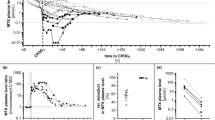Abstract
Purpose: After more than 50 years of methotrexate (MTX) treatment of acute lymphoblastic leukaemia (ALL), it is currently believed that as long as dose escalations are followed by adequate leucovorin rescue guided by monitoring MTX serum concentrations, hydration and urinary alkalinization, high-dose MTX (HD-MTX) can be tolerated without life-threatening toxicity. However, our recent experimental animal studies of the major metabolite of MTX, 7-OH-MTX, indicate that this concept may have some limitations. Animals with levels of 7-OH-MTX of 1 mM, which is below the levels routinely found in patients on HD-MTX, demonstrate intolerable toxicity and some animals die within 8 h. Electron microscopy indicates that endothelial cell and platelet functions are perturbed. Since animal data are lacking, and interspecies differences not known, we wanted to investigate the maximum tolerated doses of MTX and 7-OH-MTX in a rat model of short-term effects. The maximum tolerated dose was chosen instead of LD50 for reasons of animal welfare. Methods: We infused MTX and 7-OH-MTX into anaesthetized male Wistar rats and monitored the animals for 8 h. The drugs were given as a bolus plus continuous infusion. The dose-finding ranges were 1.8–11.3 g/kg MTX and 0.1–1.2 g/kg 7-OH-MTX. Results: The maximum tolerated dose was between 3 and 5 g/kg for MTX and lower than 0.1 g/kg for 7-OH-MTX. The mean serum concentrations of MTX and 7-OH-MTX in animals that did not survive the 8-h period were 21.9 and 1.6 mM, respectively. The animals that received the highest MTX or 7-OH-MTX doses and concentrations died after sudden reductions in heart rate and blood pressure. Conclusions: We demonstrated a lower maximum tolerated dose of 7-OH-MTX than of MTX in rats after 8 h. The 7-OH-MTX concentrations were in the therapeutic range after HD-MTX. If the rat/human interspecies differences are not large, our data may indicate that HD-MTX regimens should not be further dose intensified, due not so much to the effects of MTX as to those of 7-OH-MTX.
Similar content being viewed by others
Author information
Authors and Affiliations
Additional information
Received: 28 July 1999 / Accepted: 25 January 2000
Rights and permissions
About this article
Cite this article
Fuskevåg, OM., Kristiansen, C., Lindal, S. et al. Maximum tolerated doses of methotrexate and 7-hydroxy-methotrexate in a model of acute toxicity in rats. Cancer Chemother Pharmacol 46, 69–73 (2000). https://doi.org/10.1007/s002800000111
Issue Date:
DOI: https://doi.org/10.1007/s002800000111




